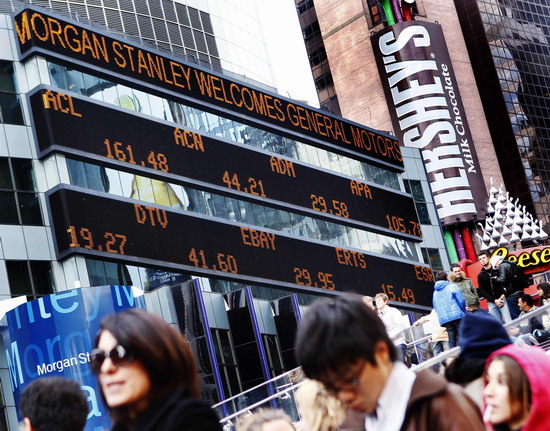GM launching IPO, ending govt majority stake
Updated: 2010-11-18 14:41
(Agencies)
|
 A message welcoming General Motors is seen on the Morgan Stanley stock ticker at their world headquarters in New York November 17, 2010. [Photo/Agencies] |
Most of the new stock will go to institutional investors, not to everyday investors, following a Wall Street system that rewards investment banks' big customers. GM will set aside 5 percent of its new stock for employees, retirees and car dealers to buy at the offering price. The deadline to sign up was October 22, but the company has not revealed how many people took the offer.
|
||||
The government has agreed that it will not sell shares outside the IPO for six months after the sale. The officials, who spoke on condition of anonymity, said they would assess their options for selling the government's stake further.
In the stock offering, the government stands to make $13.6 billion if it sells 412 million shares, as planned, for $33 apiece. It will still have about 500 million shares, a one-third stake. It would have to sell those shares over the next two to three years at about $53 a share for taxpayers to come out even.
The total bailout was $50 billion. GM has already paid or agreed to pay back $9.5 billion. That comes from cash and payments related to preferred stock held by the government.
The GM debut comes at a time when auto stocks are performing well generally. The stock of GM's crosstown rival, Ford, has risen steadily this year, from about $10 in January to about $16.50 as the GM IPO approached. The stock traded for a dollar in November 2008, and Ford never even took bailout money.
As for GM, whether bankruptcy actually fixed the company remains an open question. Before the crisis, it was saddled with debt and had a labor contract that called for paying workers even if they weren't working. Massive pension and health care costs kept GM's fixed costs high, and contracts with dealers meant it would be expensive to shut underperforming brands. Combined, those problems put the automaker in a topsy-turvy world where it made more sense to run plants at full bore, even if no one was buying cars.
Bankruptcy fixed much of that. The company closed 14 of its 47 plants, shuttered or sold off its Hummer, Saturn, Saab and Pontiac brands, and slashed its debt from about $46 billion to about $8 billion. Union retiree health care costs are now the United Auto Workers' responsibility, and the controversial jobs program that paid idled workers almost a full salary has been eliminated.
GM employs 209,000 people in the United States today, down from 324,000 in 2004. But it's making money. Before bankruptcy, GM lost about $4,000 per car. Now it makes about $2,000 each. GM says it is poised to earn about $19 billion a year when the car market rebounds.
Still, questions remain. With this stock offering, GM doesn't rid itself of government intervention. The government remains a big shareholder.
Financial problems that plagued the automaker for the past decade still don't seem under control: Despite hiring Chris Liddell, a new CFO from Microsoft known for fixing problems, GM says it's still not sure all the financial problems were fixed.
Paper's Digest

Jingle bells
The younger generation and every king of retailer are embracing the christmas holiday more than ever before across China.
Chinese shoppers boost luxury market
Growing appetite for foreign firms
Happiness quotient
Specials

If you're happy and you know it
Chinese J.K. Rowling's best-selling children's works are rapidly finding a foreign audience

Clothes maketh this man
English entrepreneur pioneers hip streetwear culture and becomes one of the locals in old Beijing.

Ich bin ein Beijinger
German sinologist's lifelong connection with China is deeply rooted.




